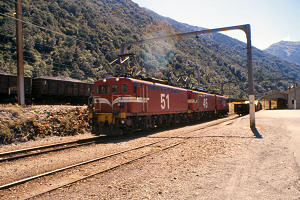
|
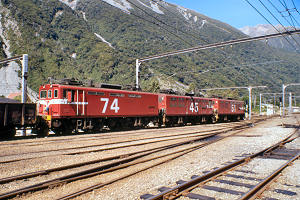
|
|
| |
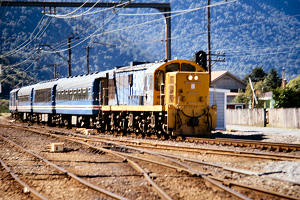
|
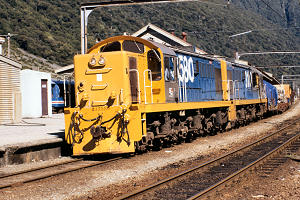
|
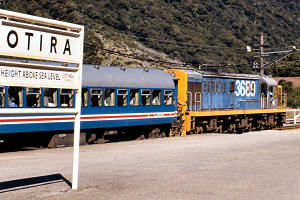
|
| |
Friday 4 March — Okarito to Arthur’s Pass (236km)
It was misty and damp in the morning. I pottered around in the hopes of it lifting but by about nine I decided that it would take another couple of hours for it to clear enough to be worth climbing to the local lookout so I headed off up the road, stopping at Hokitika to pay my accumulated VISA bill, $755 by my reckoning in the last month, mostly petrol.
I turned inland at Kumara Junction, halfway between Hokitika and Greymouth, where road and rail share a wooden trestle bridge, and headed for Arthur’s Pass with the weather clearing as I went. The railway passes under the summit of the pass through an eight and a half kilometre tunnel. When it was opened in 1923, it was considered too long for steam locos to work up the eastbound 1 in 33 gradient so provision was made for electric traction with the electric locos based at Otira at the western end. Passenger trains are diesel hauled throughout nowadays but freight trains are still taken through the tunnel by the electrics. I stopped to watch the passing of the eastbound Tranz Alpine Express and photograph the electrics.

|

|
|
| |

|

|

|
| |
The road over the pass, through the Otira Gorge, is a bit exciting in the dry, it must be terrifying in the winter snows. Much of it is built on embankments stuck on the steep hillside.
Next stop the hostel in Arthur’s Pass where I booked for two nights, taking a chance on the weather. The warden was a North American who’d had wandered in a week or two earlier and heard the regular warden complaining about the difficulty of getting someone to cover for his holidays, so he’d offered to hold the fort for a while and there he was, quite happy. I had a shower, my first for four days, washed my other pair of socks and went out for a short walk along the street. This township is the headquarters for the Arthur’s Pass National Park, has a hostel, guesthouses, various camping grounds nearby but no pub. The sun disappeared behind the hills before six o’clock, two hours before sunset.
I spent the evening in the hostel discussing possible outings for the morrow, there is lots of choice but the final decision will have to wait till I see what the weather is going to do. If it not good, a walk through the Gorge seems the best bet, taking the bus one way. Pity both buses pass through at about lunchtime.
I must remember to put the clock back tomorrow night, end of summer-time.
Saturday 5 March — Arthur’s Pass
Fine and clear this morning, I fancied climbing a mountain, Blimmit seemed a good choice, six hours round if you’re fit. I walked down to the visitor centre to check the forecast. Yesterday’s outlook was for a period of rain, then fine, but they don’t get the update till half past nine so I decided to take the chance, if the weather deteriorates I can always retreat.
So I set off up through the bush, a stiff climb on a reasonable track, took about an hour to the tree-line, then the fun started. The next bit was a belt of rock, fairly steep, pick your own gully and slither up it. A lot of scree, very loose, and the “rock” at the sides of the gully was heavily frost-shattered, coming away in chunks as soon as you put any weight on it. To add to my troubles, the bits had sharp edges and a thoughtlessly placed hand turned red.
It took an hour and a half to get through those rocks, with a lot of muttering and serious consideration of giving up (but I decided it would be worse getting back down where I’d come up). I think the worst thing was that it was a convex slope so that when I looked back, the ground disappeared below me. Once that was over, I had a glorious walk along the ridge, just minor ups and downs to break the monotony and it was usually fairly clear whether to go left, right or over each bit of rock. The views in all directions were good, just a bit of cloud on the peaks to the west.
Over the summit of Mt Cassidy and on to Blimmit (1923m), my highest so far. The cloud was getting a bit closer so I decided on a swift descent via a scree slope, concave this time so that I could see the slope easing as I went down. A quick tramp across a patch of snow in the high corrie, then a bit of a slog down to the ski-field and on down a track to the road (6 hours). It was necessary to follow that road for a bit before getting on to a nature trail which provided a pleasant return to the village.
Views from the slopes of Blimmit.
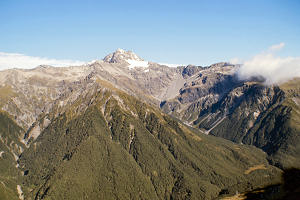
|
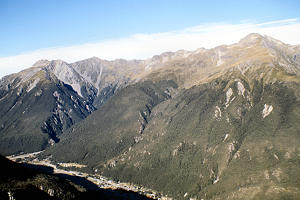
|
| Mt Rolleston (2270m) across Arthur’s Pass |
Mt Bealey (1823m) across Arthur’s Pass |
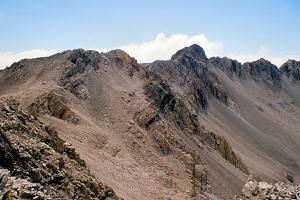
|
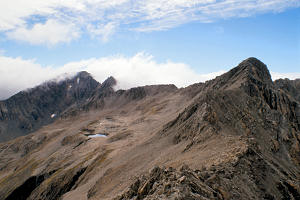
|
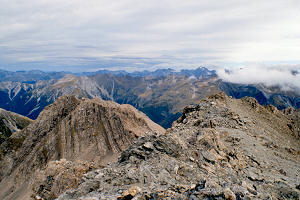
|
| Mt Cassidy (1832m) & Blimmit (1932m) |
Phipps Peak (1984m) & Blimmit (1932m) | East? from Blimmit |
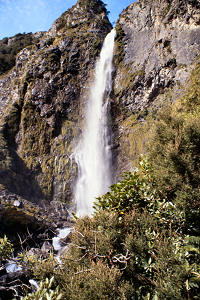
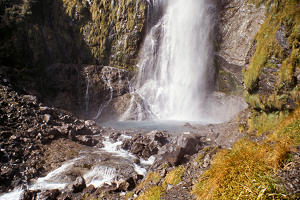
It was only four o’clock when I got back to Arthur’s Pass so I decided to have a look at the Punchbowl Falls nearby, quite high, enough water to be interesting.
Back to the hostel for a shower, polished my boots, washed both pairs of socks and cut my toenails, all preceded by a pot of tea. Then the warden came in and said there were keas outside. Keas are mountain parrots, quite big, dull green on top but with red bits under their wings. They are inquisitive and very friendly, but they can be something of a pest as they are not timid and have come to regard humans as a source of food and entertainment. All are requested not to feed them in the hopes that if they spend less time around humans, they will do less damage. Down at Fox Glacier, there was a chap feeding three of them with one hand and taking photos with a camera in his other hand, about two metres from a sign saying “do NOT feed the keas”.
They have a reputation for being destructive but it is really just that they like to play with things, like car aerials, windscreen wipers, trampers boots etc. and they do have very strong beaks. They are highly protected. You may say “shoo” to them but don’t raise your voice or it’s off to jail you go.
And now there was one standing on the roof of my car and another on the bonnet admiring its reflection in the windscreen. I think they are lovely birds but I was much relieved when they decided to move off. (Did I ever mention seeing an Eastern Rosella in the Waitakere Ranges near the golf course?)
I went over to Otira in the evening but it is not possible to enjoy an evening in the pub when you are faced with driving back over the Otira Gorge, that’s a more effective control than the breathalyser.
Sunday 6 March — Arthur’s Pass to Kaikoura (363km)
I did remember to adjust my clocks, which is more than can be said for the warden and a couple of sheepish looking guys who got up at six thirty and wondered why they were first up. Off I went, down the road towards Canterbury. Very nice scenery with some slag-heap mountains, one of which looked very like Ben Dorian (between Tyndrum and Bridge of Orchy). Turned left just past Sheffield, onto the Rangiora road, on to SH1 and up to Waipara, all without excitement.
Found the Weka Pass Railway and an engineer who used to work at Glenbrook. This railway doesn’t run, they’re still relaying the track which NZR had allowed to deteriorate beyond the point where it was acceptable for passenger services. Their borrowed Ja1260 failed its boiler test and they can’t reach agreement with the owners over the apportionment of repair costs and/or extension of the loan beyond next Labour Day. They have an A class but it is several years and a lot of money away from running. However they hope to run some excursions up part of the line at Easter using diesel power. (How far can they get at forty sleepers per day?)
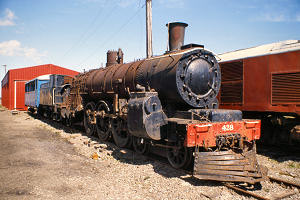
|
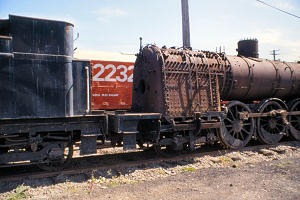
|
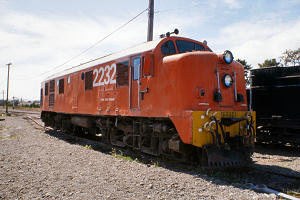
|
| A-class awaiting restoration |
||
I passed on to Cheviot for lunch then on to Kaikoura, through some very pleasant limestone? country and up the coast. I drove out to the end of the road on the peninsula and was about to drive back when I noticed a movement on an offshore rock. It turned out to be a seal, one of many on the rocks so I took a photo or two. I was surprised by their size, much bigger than I had expected. They are fur seals so perhaps they come larger than our grey seals anyway. Then I saw a South Island Pied Oystercatcher. Very common hereabouts but I haven’t seen one before.
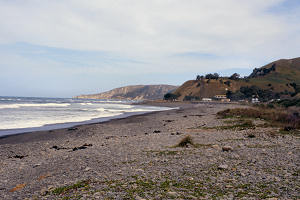
|
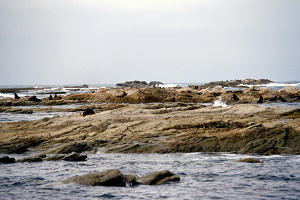
|
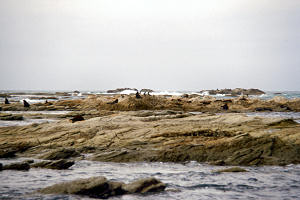
|
| Coast south of Oara |
Fur seals at Kaikoura | |
Went to the railway station to watch the Picton-Christchurch Express go past. It didn’t. A bus came instead. Booked into the hostel, fairly new, very nice, half full which is good as it was full the last couple of nights.
Monday 7 March — Kaikoura to Greymouth over the Lewis Pass (365km)
It was a grey morning in Kaikoura, not actually raining, most of the time, but it always looked like it. The hills faded quickly into mist and cloud, so I faded too, south west down the inland road into the mist and rain, then turning west towards the Lewis Pass. I stopped briefly at Hanmer Springs, a popular thermal resort, which looked exceedingly dreary in the rain, then carried on up the pass which is much less spectacular than Arthur’s Pass but I’m sure it is a nice drive when the sun shines.
The rain stopped as I approached what I think was the top and everything brightened until it was warm and sunny through thin high cloud by the time I reached Reefton. Then down the Grey River valley to Greymouth and the YH. Into the railway station to buy a ticket for the Cook Strait ferry on Thursday at 4pm, the schedule has changed because one of the boats is off for survey. Will I get to Picton in time? Watch this space.
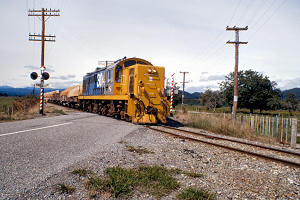
|
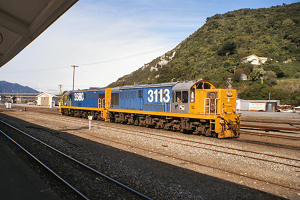
|
| Near Totara Flat |
Greymouth |
Tuesday 8 March — Greymouth to Golden Bay (400km)
Very windy overnight. They’ve been getting stick from the weather in the North Island, the tail end of Cyclone Bola. We seem to be getting the wind but without the rain that has been drowning the north east of the North Island. Gisborne has been cut off, both road and rail, the main road bridge at Wairoa has been washed away, the road around the East Cape is blocked in several places and Thames, on the Hauraki Gulf, is under threat of flooding with roads washed out on all sides. Not to mention extensive inundation of agricultural land and destruction of horticultural crops which they had only just started to pick. So, strong winds down here are nothing to complain about.
On the way north up the coast, I stopped at Punakaiki to view the Pancake Rocks again but the tide was out with only a slight swell so the blowholes were still inactive. On to Cape Foulwind, had a bit of a walk around there and then into Westport for lunch. Took a couple of German hitch-hikers from Westport to Murchison where I intended to do the Skyline Walk overlooking the town. Parked the car, put my boots on, walked five yards down the track and found a large notice “track closed till further notice”! I went to the pub instead.
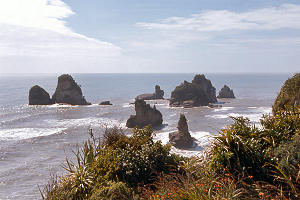
|
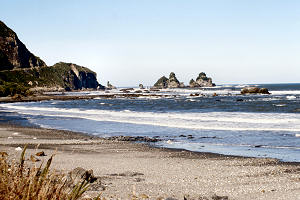
|
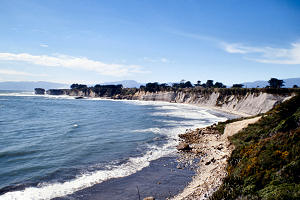
|
| (1979) |
North of Greymouth | Cape Foulwind |
After that, I drove on to Motueka at the top end of Tasman Bay, picking up a Dane in the middle of nowhere and dropping him at the junction for Nelson, where there were already two lassies hitching, so I think he might have had a long wait. Decided to carry on towards Takaka. The road goes over a massive hill, winding up for fourteen kilometres then down for ten. It was getting dark by this time, so after the hill I pulled into the Golden Bay lookout to wait for morning. Some flax bushes provided a bit of a windbreak and I had a very comfortable night.
Wednesday 9 March — Golden Bay to Havelock (360km)
Arrived in Collingwood, the end of the main road, at eight o’clock and it was still asleep, so I drove out the back road to the base of Farewell Spit. Very windy, so I just went back to Collingwood, which had by now woken up, and found out that the next excursion out onto the spit departs 0530 on Friday, so I gave up that idea.
Back through Takaka and up the hill. When I stopped to admire the view, I met a lassie who was collecting seeds from the wild flowers and other plants which are becoming endangered in the cultivated areas. Just over the top of the hill is the Ngarua Caves, a dry limestone complex with the usual complement of stalagmites and stalactites.
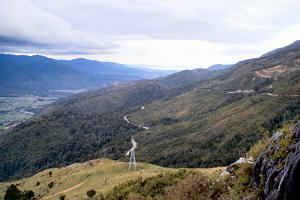
|
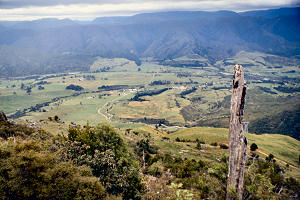
|
| Farewell Spit from Takaka Hill |
Takaka River |
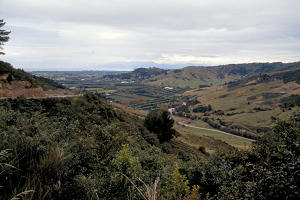
|
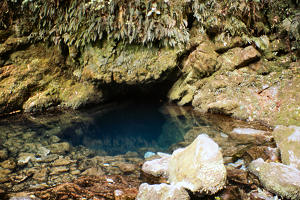
|
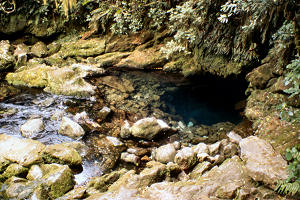
|
| Orchards near Motueka |
The source of a river | |
Lunch in Motueka, the most expensive beer in the South Island, $1.40 in one pub and $1.45 in the other for a 12oz glass, then on to Nelson where it started to rain while I was wandering around the town and docks. Vast amounts of apples and timber are exported from this port. I tried to book into the YH but it was full so I continued into the gathering gloom towards the next hostel at Havelock. Another two hitch-hikers in the middle of nowhere intended to continue towards Picton, in the dark, mad.
Havelock Hostel is a converted school where Lord Rutherford got his early education. The office was closed for tea but a passing person said that there seemed to be plenty of beds so I hung around till it reopened at eight. Booked in, showered and went to the pub. There were already some others from the hostel in there so I joined them, and a middle aged English couple came in later.
The thing here seems to be to go and see the glow-worms, so I did, just a short walk away up a lane just across from the pub. There were lots of them scattered on the bank at the side of the track, just hanging there. When I returned to the pub, I was told that I should have gone a bit further, to see even more. All in all, it was one of the more social evenings recently, perhaps because of the proximity of the hostel to the pub.
Thursday 10 March — Havelock to Wellington (116km)
Not much of a morning, weatherwise, low cloud and mist but at least it wasn’t raining. I headed back down the road towards Nelson, to go over in the light that stretch of road which is described as very scenic and which I had passed along at a rate of knots in the dusk of last evening. I wasn’t too impressed now in the daylight, perhaps it would have been better if I could have seen more than five hundred feet up the hillsides.
Rai Falls turned out to be a bit of a non-event, just a short stretch of rapids, but I did have a pleasant walk in the woods at Pelorus Bridge. As I crossed the bridge beside the car park/ tearoom. I watched a group of canoeists arrive and start trying to find a way up through some shallow rapids. I doubted if it was possible. If they tried to dig the paddles in to get the leverage to push through the channel where the water was deepest (and the current strongest), then they would risk breaking the blades on the rocks at either side. I watched for about five minutes then went off for my walk.
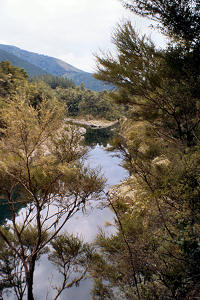
|
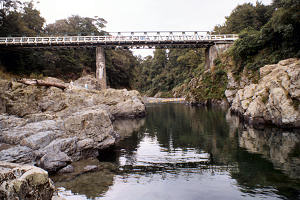
|
| Rai River |
Canoeists below Pelorus Bridge |
On my return about forty-five minutes later, they were still at it, and it was some minutes later before they seemed to give up and start going ashore on the shingle, presumably to carry the canoes round, or perhaps to go for a cup of tea. I certainly did.
I drove on to Picton and watched the Arahura arrive as if for a 1420 sailing, which she was. Odd, because I got the impression that it was she who was off for survey. Anyway, I had a beer and waited for the Aratika at four o’clock. By this time it was raining, the cloud was down and the mist was even lower so the whole crossing was pretty grey, but, thankfully, smooth. I don’t know what happened to the forecast 35 knot winds.
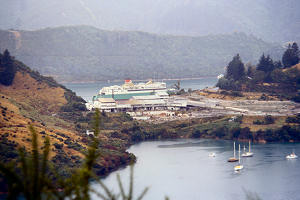
|
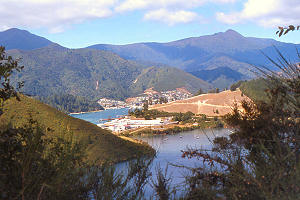
|
| Arahura arriving at Picton |
(A similar shot from 1979) |
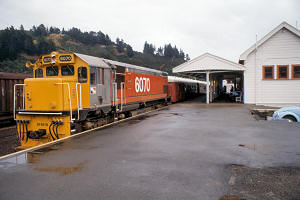
|
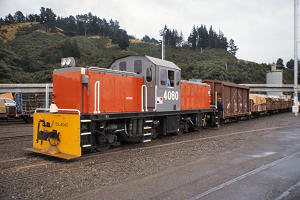
|
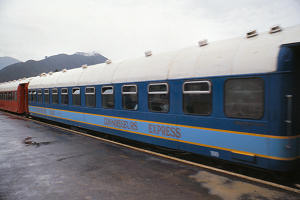
|
| Picton-Christchurch Express |
Manoeuvring the cargo | Luxury travel |
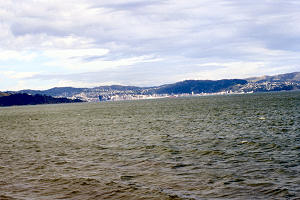
Wellington from the ferry
Arriving in Wellington was a bit of a shock, dark, wet and fast traffic, a bit of a change after four weeks of leisurely travel on the South Island. Found my way up to Karori and bludged a bed for the night.
Friday 11 March — Wellington to Kaitoke (116km) via the Rimutaka Incline
William and Hannah were in good form in the morning, playing up in front of the visitor. Anne took them off to school and kindy, and I went on my way. I missed the turning for Johnsonville, it was hidden by the long line of cars commuting into town, but just carried on anyway expecting to find another. When I hadn’t after some considerable distance, and the lie of the land suggested that I was heading into a dead-end canyon, I stopped and consulted the map.
There was a road from the back end of Karori so I carried on, twisting, narrow and after a bit, unsealed. Luckily I met only one other car and it was a Mini which got past OK. The road improved again as it approached Johnsonville and I noticed a very pleasant house in a natural hollow, with a large lawn and a pool in front. Then I thought I’d seen it before. Then I realised that this was where Dave’s Mini was found almost five weeks before.
Anyway, I carried on and found my way to the coast road around Port Nicholson, to admire Wellington across the water. Then on up through the towns in the Hutt Valley, and across the Rimutaka Range into the Wairarapa, stopping at the tearoom at the top of the hill Just before Featherstone, I turned right and followed the minor road south along the foot of the Ranges to the bottom of what was once the Rimutaka Incline. This was a Fell railway, with special engines with extra wheels to exert lateral pressure on a central third rail to help climb the 1 in 13 gradient, built as a temporary expedient to complete the line from the Wairarapa to Wellington, which survived for seventy odd years until the Rimutaka Tunnel was opened in 1955.
The Incline is now a pleasant stroll up the hill, through three short tunnels to the Summit Tunnel which is about five hundred metres long and proved slow going as it was a bit wet underfoot and I had left my torch in the car. It had been a fine morning in Wellington but a little cloud had developed and this was still increasing when I went into the tunnel. When I emerged on the Wellington side, the cloud cover was much thicker. I had a quick look around the grassy picnic area which was once a bustling station yard, then headed back downhill.
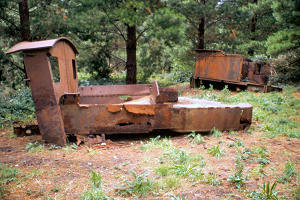
|
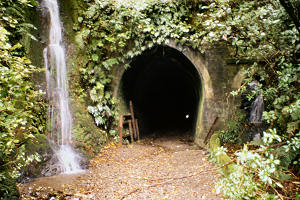
|
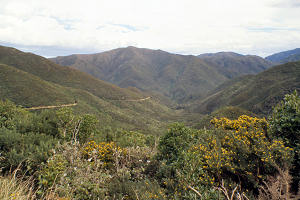
|
| Relics at Summit |
Summit Tunnel | The track |
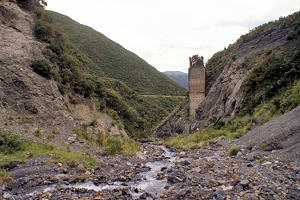
|
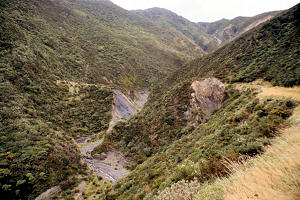
|
| Siberia Gully |
|
As I neared Cross Creek, at the bottom of the Incline, the sky became quite threatening and the first raindrops fell when I was six feet short of the shelter over the information board. While I was reading this board, and giving thought to whether I should put on my waterproof jacket, a herd of cattle (both sexes) came along to see what I was doing.
They formed a semi-circle in front of the shelter and two of the larger ones (not cows) came quite close, but moved back a bit when I stamped my foot at them. Then another one suddenly stuck a head round from the back of the shelter, I hadn’t noticed him setting up the flank attack, but he also retreated when I stamped. I didn’t like to stamp too often in case it was interpreted as a challenge for leadership of the herd, and I didn’t want to rush at them in case I started a stampede, so I just said “shoo” whenever they looked like moving in closer.
After a bit, those on the fringes lost interest and began to drift off towards the farmhouse, where I suspect they had been going in the first place, until there was just the two bulls left. By this time the rain had stopped so I shouldered my pack and as I walked forward the bulls backed off, though not much. Still, I got past them and took the track towards the car park, carefully closing the gates behind me.
By the time I was back in the car, it was about four thirty so I decided to buy supplies in Featherstone and return over the Rimutakas to the hostel at Kaitoke. This was a pleasant place, tended by an elderly lady who also ran the smallest Post Office in New Zealand (now closed). The plumbing was a bit peculiar and I decided against trying to use the shower. There were two Alaskans in residence, and another chap who was loading his car when I arrived and then vanished, leaving the car behind, and there was still some otherwise unclaimed gear in one of the smaller rooms. The Alaskans retired early leaving me in splendid isolation listening to the occasional shower of rain on the roof. My pen is running out. The forecast for tomorrow is fine.
Saturday 12 March — Kaitoke to Taupo (425km)
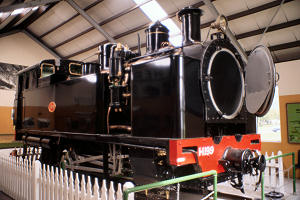
So much for weather forecasts. It was a grey morning. The mystery man with the car must have returned after I retired last night as I heard an extra voice in the common room, but he was gone by the time I got up. I don’t know why people get up so early in this sort of weather. I left about nine and drove over the Rimutakas again to Featherstone where there is the Fell Engine Museum.
A few years ago, they recovered the engine which had graced the local children’s play ground for twenty years, restored it and moved it indoors. There was a working party laying a path outside in front of a few spectators, one of whom detached himself and accompanied me around the small museum, lamenting that they had preserved one of the three Bristol-built engines rather than one of the two Scottish-built ones which apparently had been fitted with more interesting valve gear. Either way, their engine is the sole remaining Fell engine in the world.
Off up SH2, up the Wairarapa, along the edge of the ranges. It was raining on the hills, sunny on the plain and just a drift of drizzle on me in between. Through the Manawatu Gorge, road, river and rail in a narrow cut through the hills. Much of the road has been built out on piles to give one lane in each direction, the railway on the other side of the river is single track and unlikely to be widened.
Along to Bulls then up SH1 to Taihape for afternoon beer. The weather had improved as I came through the Gorge and was fine as I set off again up the Desert Road past the mountains, at least it was fine where I was but the mountains were as usual obscured by cloud. I have this theory that there really aren’t any mountains there, it’s just a ploy by the Tourist Corporation, after all, it’s just been a lot of cloud every time I go past.
Never mind, it was a fine evening when I stopped in Taupo and found accommodation at a “budget” hotel/motel at $38 but it did have a TV in the room which kept me awake till well after bed time.
Sunday 13 March — Taupo to Auckland (380km)
A grey morning again, this time without much prospect of improvement. I had a look at the Huka Falls, but couldn’t get a good photo of it as the lookouts are all in the wrong place for photography. It’s not so much a falls, more a narrow gorge that the Waikato goes through at a rate of knots.
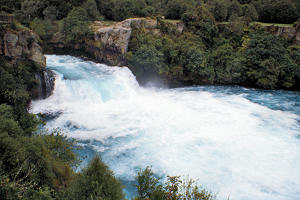
|
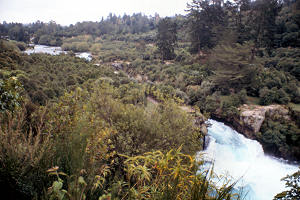
|
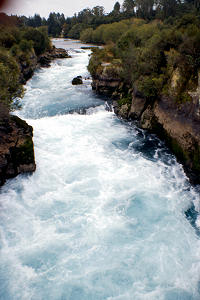
|
| |
Next stop, the thermal power station at Wairakei, lots of pipes gathering steam from numerous bores and taking it to the power station. Lots of leaks.
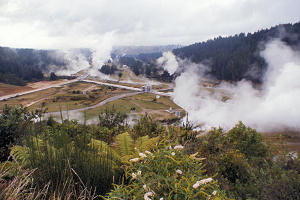
|
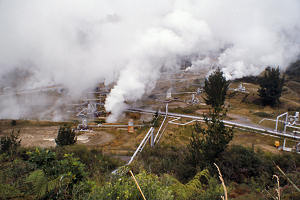
|
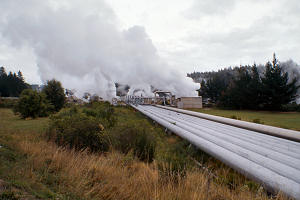
|
| |
Straight up SH1 from there to Huntly, then across the Waikato and along PH22 to a party at Pauline and Wayne’s at Tuakau, where there was a sheep and a pig on the spit. Very pleasant, with the usual problem that every time I said I had to go, another beer appeared. I accepted an invitation to stay with Al and Claudia for a couple of nights.
Monday 14 March — Auckland (60km)
A business day. I went into EDP for morning tea and a chat, no-one said that they had had any serious problems but I got the impression that things had not gone entirely smoothly since my departure. Down to the Australia Travel Shop to find a new set of staff and no record to show that they were any further forward in the attempt to book my steam train from Sydney to Perth. So, they’ll try to sort something out in the next week, and I went for a beer.
I bought some Australian and US dollar travellers cheques and went for another beer. Then along to the railway station to buy a three week Travelpass and book the first week’s movements. The railway from Napier to Gisborne is likely to be out for some time to come so I won’t be going there first, I’ll go to Invercargill instead.
Next to Avtec (the photography shop near work) to put in eight rolls of film for processing. The girl behind the counter (Juliet, who reappears later) knew my name. I hadn’t realised that I’d been such a nuisance over the last year what with Agfa withdrawing postal processing and my concern about what sort of slide mounts the various processing labs would supply. I’ll pick up this lot un-mounted next week, except the Kodak one which has to go to Australia for processing! - that takes two weeks.
Then over to ICL for a social call on the engineers, even though it is not Friday, apparently my car is not going back to Giltrap after all so I could have kept it till the end of the month, but I’ve just bought the Travelpass for the last week of the month so I’ll stick by the arrangement. The biggest drawback is the fact that I will have to clean the car when I return it as it goes straight to someone else.
Over to Denis and Robyn’s to see Kala’s thirteen puppies. They are only two weeks old and not taking much notice of anything yet.
[ next chapter ]
John Reynolds — March 2013